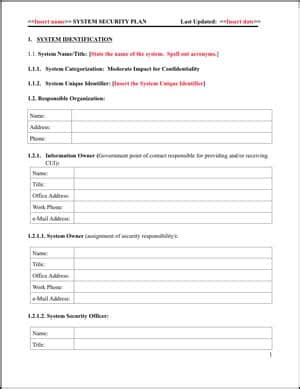The NIST SP 800-171 SSP template is a crucial document for organizations that handle Controlled Unclassified Information (CUI) to demonstrate their compliance with the National Institute of Standards and Technology (NIST) Special Publication 800-171 (SP 800-171) security requirements. In this article, we will provide a comprehensive guide and example of the NIST SP 800-171 SSP template to help organizations create a robust System Security Plan (SSP).
What is NIST SP 800-171?
NIST SP 800-171 is a set of guidelines for protecting CUI in non-federal information systems and organizations. It provides a set of security requirements for safeguarding CUI, including access control, incident response, risk assessment, and system security planning. The guidelines are mandatory for organizations that handle CUI, including federal contractors, universities, and research institutions.
What is a System Security Plan (SSP)?
A System Security Plan (SSP) is a comprehensive document that outlines an organization's security controls, policies, and procedures for protecting CUI. The SSP is a critical component of the NIST SP 800-171 compliance framework, as it demonstrates an organization's commitment to implementing the required security controls.
NIST SP 800-171 SSP Template Guide
The NIST SP 800-171 SSP template is a structured document that outlines the security controls, policies, and procedures for protecting CUI. The template is divided into several sections, each addressing a specific aspect of the security requirements. Here is a brief overview of the template sections:
- System Information: This section provides an overview of the system, including its purpose, scope, and boundaries.
- Security Controls: This section lists the security controls implemented to protect CUI, including access control, incident response, risk assessment, and system security planning.
- Implementation Status: This section provides an update on the implementation status of each security control, including any plans for remediation or mitigation.
- Responsibilities: This section outlines the roles and responsibilities of personnel involved in the security of the system.
- Training and Awareness: This section describes the training and awareness programs in place to ensure personnel understand their security responsibilities.
- Incident Response: This section outlines the incident response plan, including procedures for responding to security incidents.
- Continuous Monitoring: This section describes the continuous monitoring program, including procedures for ongoing security assessments and evaluations.
Example of NIST SP 800-171 SSP Template
Here is an example of a completed NIST SP 800-171 SSP template:
System Information
- System Name: XYZ Research System
- System Purpose: The XYZ Research System is a web-based application used to store and manage research data.
- System Scope: The system is used by researchers and staff at XYZ University to store and manage research data.
- System Boundaries: The system includes all hardware, software, and network components used to store and manage research data.
Security Controls
- Access Control: The system uses role-based access control to restrict access to authorized personnel.
- Incident Response: The system has an incident response plan in place, which includes procedures for responding to security incidents.
- Risk Assessment: The system undergoes regular risk assessments to identify and mitigate potential security risks.
- System Security Planning: The system has a comprehensive security plan in place, which includes procedures for ongoing security assessments and evaluations.
Implementation Status
- Access Control: Implemented
- Incident Response: Implemented
- Risk Assessment: Implemented
- System Security Planning: Implemented
Responsibilities
- System Administrator: Responsible for implementing and maintaining security controls.
- Researchers: Responsible for following security policies and procedures.
- IT Staff: Responsible for providing technical support for security-related issues.
Training and Awareness
- Security Awareness Training: All personnel undergo annual security awareness training.
- Role-Based Training: Personnel with security responsibilities undergo role-based training.
Incident Response
- Incident Response Plan: The system has an incident response plan in place, which includes procedures for responding to security incidents.
- Incident Response Team: The incident response team includes the system administrator, IT staff, and researchers.
Continuous Monitoring
- Ongoing Security Assessments: The system undergoes regular security assessments to identify and mitigate potential security risks.
- Continuous Monitoring Program: The system has a continuous monitoring program in place, which includes procedures for ongoing security evaluations.
Gallery of NIST SP 800-171 SSP Template Examples





FAQs
What is NIST SP 800-171?
+NIST SP 800-171 is a set of guidelines for protecting Controlled Unclassified Information (CUI) in non-federal information systems and organizations.
What is a System Security Plan (SSP)?
+A System Security Plan (SSP) is a comprehensive document that outlines an organization's security controls, policies, and procedures for protecting CUI.
Why is the NIST SP 800-171 SSP template important?
+The NIST SP 800-171 SSP template is important because it provides a structured document that outlines an organization's security controls, policies, and procedures for protecting CUI.
In conclusion, the NIST SP 800-171 SSP template is a critical document for organizations that handle Controlled Unclassified Information (CUI). By following the template guide and example provided in this article, organizations can create a robust System Security Plan (SSP) that demonstrates their compliance with the NIST SP 800-171 security requirements. Remember to regularly review and update your SSP to ensure ongoing compliance and effective security practices.
